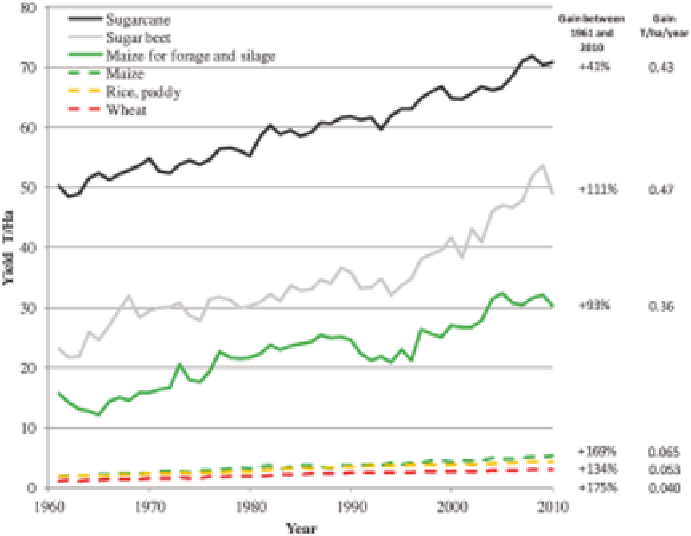Biology Reference
In-Depth Information
Fig. 13.2.
Changes in sugarcane yield between 1961 and 2010. Comparison with other grass crops
(FAOSTAT 2012). For a color version of this figure, please refer to the color plate.
growing world population (Anonymous 2012).
These increasing demands will stimulate new
scientific research investments to improve the
efficiency of varietal development programs.
Using conventional experimental approaches,
breeding new sugarcane cultivars requires at
least 10 to 15 years of selection. In the past two
decades, much research has been dedicated to
developing genomic tools that have improved
our understanding of the genetic and genomic
organization of sugarcane with the aim of facili-
tating varietal development. However, today the
direct use of these tools in breeding remains
challenging. Few applications derived from these
genomic data have been implemented in sugar-
cane breeding programs and improved yields.
The main reasons for these few applications
could be the polygenic nature of yield control
associated with the high complexity of the sug-
arcane genome.
In this chapter, after a review of the sugarcane
evolution and breeding history that led to the
present-day cultivar genomes (
Saccharum
spp.)
and a summary of yield improvement, we dis-
cuss the genomic tools developed for sugarcane
genome analyses, their potential applications,
and the challenges involved in their use for yield
improvements in “real life” breeding programs.
History of Sugarcane Yield
Improvement
Evolution and Domestication
Sugarcane (
Saccharum
spp.) belongs to the
Poaceae family and the Andropogoneae tribe,
along with maize and sorghum. The former '
Sac-
charum
complex' concept encompasses the five
closely related genera
Saccharum
,
Erianthus
,
Sclerostachya
,
Narenga
, and
Miscanthus,
which
are characterized by cross-fertility (Daniels and
Roach 1987). These genera are a potential source
of diversity for sugarcane breeding. Species
in
the
'
Saccharum
complex'
are
all
highly

Search WWH ::

Custom Search